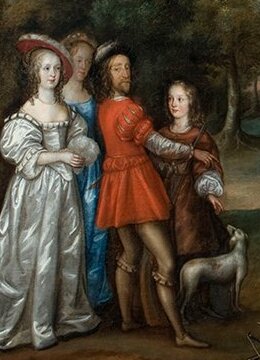Joan Carlile facts for kids
Quick facts for kids
Joan Carlile
|
|
|---|---|

A self-portrait of Carlile and her family from a larger work, The Carlile Family with Sir Justinian Isham in Richmond Park
|
|
| Born |
Joan Palmer
c. 1606 |
| Died | 1679 London
|
| Resting place | Churchyard of Petersham Parish Church |
| Nationality | English |
| Known for | Portrait painting |
| Spouse(s) | Lodowick Carlell or Carlile |
| Signature | |
Joan Carlile (born around 1606, died 1679) was an English portrait painter. She is known as one of the first British women to work as a professional artist. Before her, most professional female painters in Britain came from other parts of Europe.
Contents
Life of Joan Carlile
Joan Carlile was born as Joan Palmer. Her father, William Palmer, worked for the Royal Parks. Her mother's name was Mary.
Joan was very skilled at painting. She would copy famous works by Italian masters (great Italian artists). She also created her own original paintings, often in a very small size, called miniatures.
Family Life and Homes
In July 1626, Joan married Lodowick Carlell. He was a gentleman who worked for King Charles I. Lodowick was also a poet and a writer of plays.
From 1637 to 1663, Joan and Lodowick lived at Petersham Lodge. This was in Richmond Park, where Lodowick worked as a park keeper.
They moved to Covent Garden in London in 1654. However, they returned to Petersham two years later. This was after the king was restored to power. Lodowick got his job back as "Keeper of the house or Lodge and the Walk at Petersham."
In 1665, they moved back to London for good.
Later Years and Legacy
Lodowick died in 1675. He was buried in the churchyard of Petersham Parish Church. This church was in Surrey at the time. Today, it is part of the London Borough of Richmond upon Thames.
Joan was living in the parish of St Martin-in-the-Fields when she died in 1679. She was buried next to her husband on February 27th.
Joan and Lodowick had three children. Their names were Penelope, James, and Edmund. Penelope married a lawyer named John Fisher. James had two sons, James and Lodowick.
Joan Carlile's Artworks
Joan Carlile created many beautiful portraits. Her paintings are now held in famous galleries and collections.
Famous Portraits
One of Carlile's well-known paintings is Lady Dorothy Browne and Sir Thomas Browne. You can see this portrait at the National Portrait Gallery in London. The gallery also has another portrait of Sir Thomas Browne that is believed to be by her.
In 2016, the Tate art museum bought one of Carlile's paintings. It is called Portrait of an Unknown Lady and was painted between 1650 and 1655.
Paintings in Collections
A painting from around 1648 shows Elizabeth Murray, Countess of Dysart with her husband and sister. Experts believe Joan Carlile painted it. This artwork is owned by the National Trust. It is on display at Ham House. Another portrait of the Countess of Dysart, also thought to be by Carlile, is at Thirlestane Castle.
The Carlile Family Painting
The Carlile Family with Sir Justinian Isham in Richmond Park is a large painting. It is kept at Lamport Hall in Lamport, Northamptonshire. This painting is also known by other names, like A Stag Hunt. It was shown at the Tate Gallery in 1972. This important work has helped art experts identify other paintings as Carlile's.
Another painting by Carlile is a full-length portrait of a lady. She is wearing a white dress and a purple cloak. Many believe this lady is Lady Anne Wentworth. This painting is currently in a private collection.
In 2005, a small portrait (a miniature) was sold at an auction by Sotheby's. It was described as A Lady, Wearing White Dress With Brooch At Her Corsage.... This miniature is also believed to have been painted by Joan Carlile.
See also


